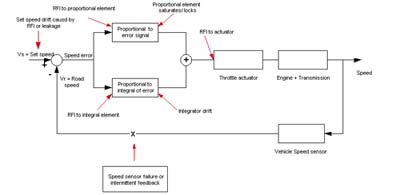by Dr Antony Anderson C.Eng FIEE
4. Cruise Control : functional aspects and possible modes of failure
Most cruise control systems are functionally very similar and appear to be of the "proportional + integral" (PI) type of closed loop control system. Cruise control systems are likely to exhibit similar failure modes and have the same potential for exhibiting suboptimal performance as other industrial and domestic PI control systems because they use the same electronic technology.

Block diagram of cruise
control system showing some areas of vulnerability
The automobile engine compartment is a particularly unfavourable environment in which to expect sensitive electronics to operate reliably:
- It is hot, dirty, humid and vibration levels are high;
- Electromagnetic Interference (EMI) levels can be high;
- There can be appreciable shock loadings that may damage PCB wiring or affect electrical contacts;
- Electrical connectors can become dislodged or distorted
- Electrical contacts be subject to fretting fatigue;
- Wiring, if not properly restrained, can be rapidly damaged by vibration-induced fretting;
- Servicing of the vehicle, involving the removal and replacement of components, may result in displacement or damage to wiring or unwitting damage to connectors or sometimes the wrong connections being made..
- Sensors, switches, connectors and wiring :
- a speed sensor or its wiring may fail;
- electrical switches may fail to open or fail to close;
- electrical switches may become mispositioned, loose or fall off;
- multiplexed switches, where several switches communicate with a control module over a single wire, may not switch correctly in the presence of a high-resistance joint or earth contact
- electrical connectors may fail open circuit or short circuit;
- electrical switches or wiring may overheat causing damage;
- slip ring connections (to steering wheel switches, for example) may become intermittent or fail;
- earthing connections may become intermittent or fail;
- presence or absence of extreme cold/ heat, moisture, pollution, road salt etc. may play a significant role here.
- presence of monocrystalline tin whiskers resulting
from the use of lead free solder that may cause
intermittent shorts. See NASA tin
whiskers page for information on this subject.
- The Electronic Control Unit (ECU):
- electronic components may fail;
- vibration, shock or thermal cycling; may cause intermittent open or short circuits on PCBs;
- moisture and surface contamination may cause electrical tracking across insulating surfaces, in turn causing :
- the speed reference signal to drift, either up or down;
- a high gain amplifier or integrator, or digital equivalent, to drift into saturation;
- logic may be affected by transient signals/noise;
- logic may lock on or lock off.
- a microprocessor may get into an endless processing loop
- The throttle actuator
- There are various different kinds of actuator used ( electro-pneumatic and electro-mechanical) but they are all essentially power amplifiers, converting a small control signal into throttle movement. The result of an input signal, whatever its source, will be movement of the throttle. Spurious control signals may derive from many sources including :
- RF noise at the input;
- false signals from a malfunctioning cruise control module;
- stray potentials resulting from perhaps poorly earthed components elsewhere in the engine compartment;
- wiring faults.
- The actuator has mechanical elements that have the potential to jam in any position from fully closed to fully open.
- external to the cruise control/actuator modules (external fault mechanisms)
- internal to the cruise control/actuator modules (internal fault mechanisms)
Don't forget to bookmark Section 9 Links and References before leaving this site.